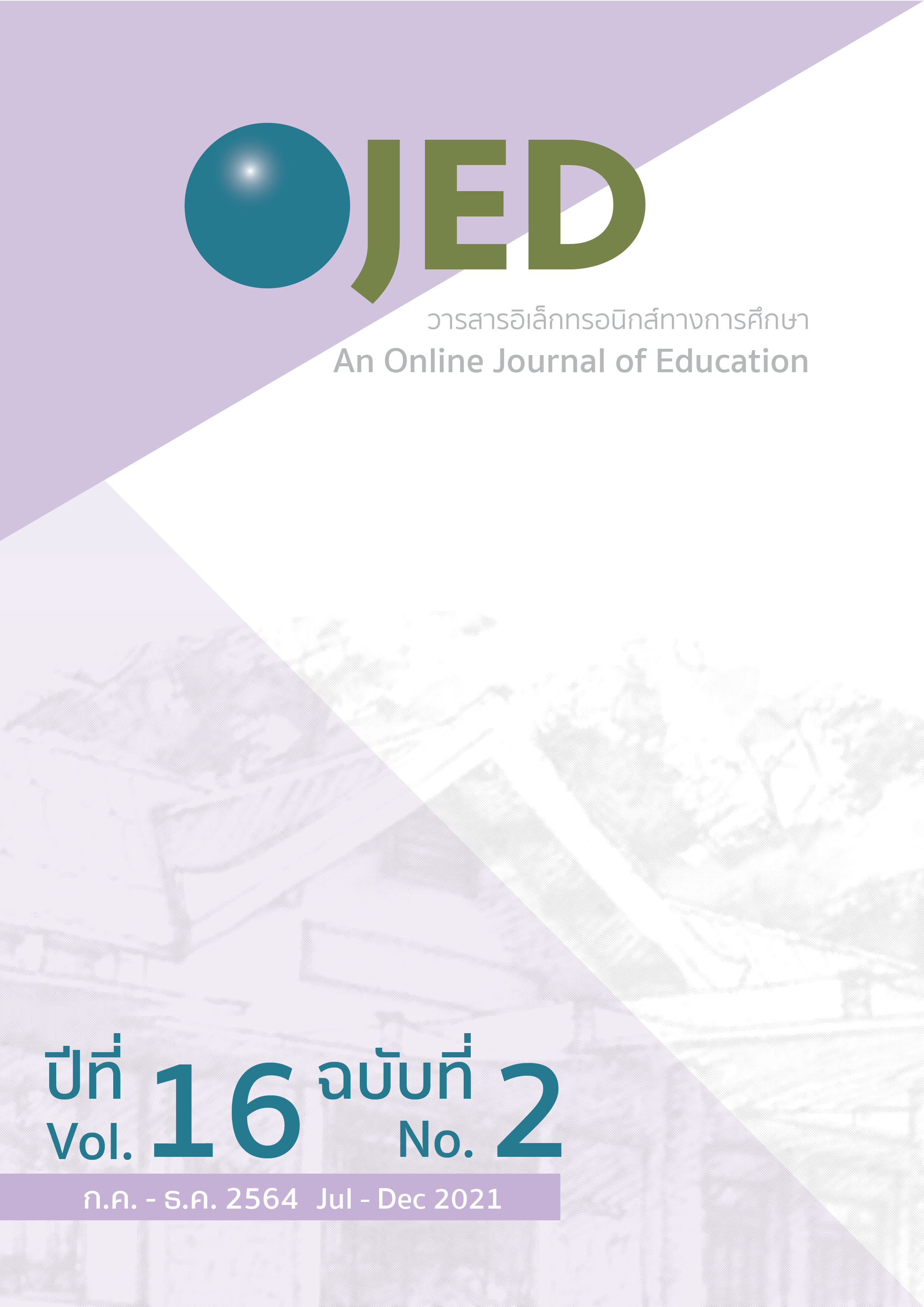ความสัมพันธ์ระหว่างการอ่านนอกเวลาในฐานะกิจกรรมนอกหลักสูตรของโรงเรียนกับความสามารถในการเล่านิทานเป็นภาษาอังกฤษของนักเรียน : กรณีศึกษาโรงเรียนพระหฤทัยดอนเมือง
คำสำคัญ:
การอ่านหนังสือนอกเวลา, กิจกรรมเสริมนอกหลักสูตร, การเล่านิทานเป็นภาษาอังกฤษบทคัดย่อ
งานวิจัยนี้เป็นการศึกษาถึงความสัมพันธ์ระหว่างการอ่านหนังสือนอกเวลาในฐานะเป็นกิจกรรมนอกหลักสูตรของโรงเรียนกับความสามารถในการเล่านิทานเป็นภาษาอังกฤษของนักเรียน โดยมีวัตถุประสงค์เพื่อ 1) ค้นหาว่ากิจกรรมการอ่านนอกเวลามีส่วนช่วยเสริมสร้างความสามารถในการเล่านิทานเป็นภาษาอังกฤษอย่างไร และ 2) ศึกษาว่านักเรียนใช้กลยุทธ์อะไรในการถ่ายทอดสิ่งที่อ่านออกมาเป็นภาษาพูด งานวิจัยนี้ใช้กรณีศึกษา ซึ่งคัดเลือกจากนักเรียนผู้ชนะในการแข่งขันเล่านิทาน ปีการศึกษา 2557 จำนวน 3 คน ประกอบไปด้วย นักเรียนระดับประถมศึกษาปีที่ 1 นักเรียนระดับประถมศึกษาปีที่ 5 และนักเรียนระดับมัธยมศึกษาปีที่ 3 โรงเรียนพระหฤทัยดอนเมือง และครูต่างชาติที่รับหน้าที่เป็นกรรมการในการตัดสินการแข่งขันเล่านิทานปีการศึกษา 2557 จำนวน 3 ท่าน งานวิจัยนี้ใช้การสัมภาษณ์แบบทั้งครูและนักเรียนและหลักฐานจากใบรายงานการให้คะแนนในการแข่งขันเล่านิทานเป็นภาษาอังกฤษ โดยการวิเคราะห์ข้อมูลใช้การบรรยาย ผลการวิจัยพบว่ากิจกรรมการอ่านนอกเวลามีส่วนช่วยเสริมสร้างความสามารถในการเล่านิทานเป็นภาษาอังกฤษได้และกลยุทธ์ในการถ่ายทอดสิ่งที่อ่านออกมาเป็นภาษาพูดนั้นกรณีศึกษาใช้การแปล การจินตนาการ และสื่อต่าง ๆ เช่นรูปภาพ บทพูดจากการใช้กลยุทธ์ดังกล่าวช่วยให้กรณีศึกษาเล่านิทานได้อย่างมั่นใจและถูกต้อง
References
reading comprehension of Saudi elementary stage students. Journal of King Saud University–Languages and Translation 2(23), 69–76. doi: 10.1016/j.jksult.2011.04.001
Applebee, A. (1978). The child’s concept of story. University of Chicago Press.
Association of American Colleges and Universities report. (2002). Greater expectations: A new
vision for learning as a nation goes to college. Association of American Colleges and Universities.
Bright, J. A., & McGregor, G. P. (1977). Teaching English as a second language. Longman.
Bell, T. (2001). Extensive reading: Speed and comprehension. The Reading Matrix, 1.
http://www.thereadingmatrix.org/articles/Bell-reading.htm
Brown, R. (2000). Extensive reading in the EFL class: Extensive reading in practical colloquieum. Shizuoka.
Caraway, T. (1994). A study of the relation of story telling abilities and reading comprehension in fourth and sixth grade AfricanAmerican children.
University of Oklahoma Health Sciences Center.
Cho, K–S., & Krashen, S. D. (1994). Acquisition of vocabulary from the sweet valley kids series: Adult SL acquisition. Journal of Reading, 37, 662-667.
Constinto, R. (1995). Learning to read in a second language doesn’t have to hurt: The effect of pleasure reading. Journal of Adolescent & Adult Literacy, 39, 68-69.
Crevola, Carmel, and Mark Vineis. (2005). Let's talk about it. Research and background information on teaching oral language. NY MONDO Publishing.
Dao, T. N. (2014). Using internet resources for extensive reading in an EFL context. Hawaii Pacific University TESOL Working Paper Series, 12, 72-95.
Day, R. R., & Bamford, J. (1998). Extensive reading in the second language classroom. Cambridge University Press.
Day, R. R., & Bamford, J. (2002). Top ten principles for teaching extensive reading. Reading in a foreign language, 14, 136–141.
Davis, C. (1995). Extensive reading: and expensive extravagance. ELT Journal, 49, 329-335.
Elley, W. B., & Mangubhai, F. (1983). The impact of reading on second language learning. Reading Research Quarterly, 19, 53-67.
Elley, W. B. (1991). Acquiring literacy in a second language: The effect of book-based programs. Language Learning, 41, 375-411.
Felten, P. (2008). Visual literacy. Change: The magazine of higher learning 40(6), 60-64
Gallagher, G. (2005). Tell me a story: Developmentally appropriate retelling strategies. Library Media Connection, 23(7), 101.
Gallets, Matthew P. (2005). Storytelling and story reading: A comparison of effects on children's memory and story comprehension. Electronic theses and dissertations.
Golden, J. (1981). Children's concept of story in reading and writing. The Reading Teacher, 37, 578-593.
Grabe, W. (2009). Reading in a second language: moving from theory to practice. Cambridge University Press.
Grabe, W., & Stoller, F. L. (2011). Teaching and researching reading. (2nd ed.).Pearson Education.
Hafiz, F., & Tudor, I. (1989). Extensive reading and the development of reading skills. ELT Journal, 43(1), 4-11.
Hafiz, F. M., & Tudor, I. (1990). Graded readers as an input medium in L2 learning. System, 18(1), 31-42.
Hayashi, K. (1999). Reading strategies and extensive reading in EFL classes. RELC Journal, 30, 114-132.
Hedge, T. (1985). Using readers in language teaching. Modern English Publications.
Hetzroni, O. E. (2004). AAC and literacy. Disability & Rehabilitation, 26(21/22), 1305- 1312.
Horst, M. (2005). Learning L2 vocabulary through extensive reading: A measurement study. The Canadian Modern Language Review, 61, 355–382.
Iwahori, Y. (2008). Developing reading fluency: A study of extensive reading in EFL. Reading in a Foreign language, 20, 70–91.
Krashen, S. D. (1993). The power of reading: Insight from the research. Libraries Unlimited.
Lai, F-K. (1993). The effect of a summer reading course on reading and writing skills. System, 21, 87-100,
Laughton, J. & Morris, N. (1989). Story grammar knowledge of learning disabled students. Learning Disabilities Research, 4(2), 87-95
Lidle. R. L. (2014). Learning to retell stories through comparative teaching: writing and drawing. Theses and Dissertations--Art & Visual Studies.
Loucky, J. P. (2005). Finding better ways to systematically maximize lexical acquisition byusing a Depth of Lexical Processing Taxonomy, CALL resources, and effective strategies. CALICO Journal, (1), 22-23.
Janopoulos, M. (1986). The relationship of pleasure reading and second language writing proficiency. TESOL Quarterly, 20(4), 763-768.
MacDonald, M. (1993). The Storytellers Start-Up Book. August House.
Maguire, J. (1985). Creative Storytelling. McGraw Hill Book Company.
Malmeer. E. & Araghi. S. M. (2013). The impact of extensive reading programs on the pronunication accuracy of F learners at basic levels. Theory and Practice in
Language Studies, 3(8), 1434-1439.
Manson, B., & Krashen, S. D. (1997). Extensive reading in English as a foreign language. System, 25, 91-102.
Nation, P. (1997). The language learning benefits of extensive reading. The Language Teacher, 21, 13-16.
Richards, J. C., & Schmidt, R. (2002). Longman dictionary of language teaching and applied Linguistics. (3rd ed.). Pearson Education.
Robb, T. N., & Susser, B. (1989). Extensive reading vs skills building in an EFL context. Reading in a Foreign Language, 5, 239-351.
Robertson, L., Dow, G., & Hainzinger, S. (2006). Story retelling patterns among children with and without hearing loss: effects of repeated practice and parent-child attunement. Volta Review, 106(2), 147-170.
Sheu, S. P-H. (2003). Extensive reading with EFL learners at beginning level. TESL Reporter 36(2), 8-26.
Soundy, C. S., Guha, S., & Qiu, Y. (2007). Picture power: Placing artistry and literacy on the samepage. Young Children, 62(3), 82-88.
Stadler, M. A., & Ward, G. C. (2010). The effect of props on story retells in the classroom. Reading Horizons, 50(3), 169-192.
Strong, C.J. & Hoggan, K. (1996). The magic of stories. Thinking Publications.
Swain. M. (1995). Three functions of output in second language learning. Oxford University Press.
Tsang, W. (1996). Comparing the effects of reading and writing on writing performance. Applied Linguistics, 17, 210–233.
Wellhousen. K. (1993). Eliciting and Examining Young Children's Storytelling. Journal of Research in Chilhood Education. 7(2), 62-66
Zhang. Y. (2009). Reading to speak: Integrating oral communication skills. English Teaching Forum.



